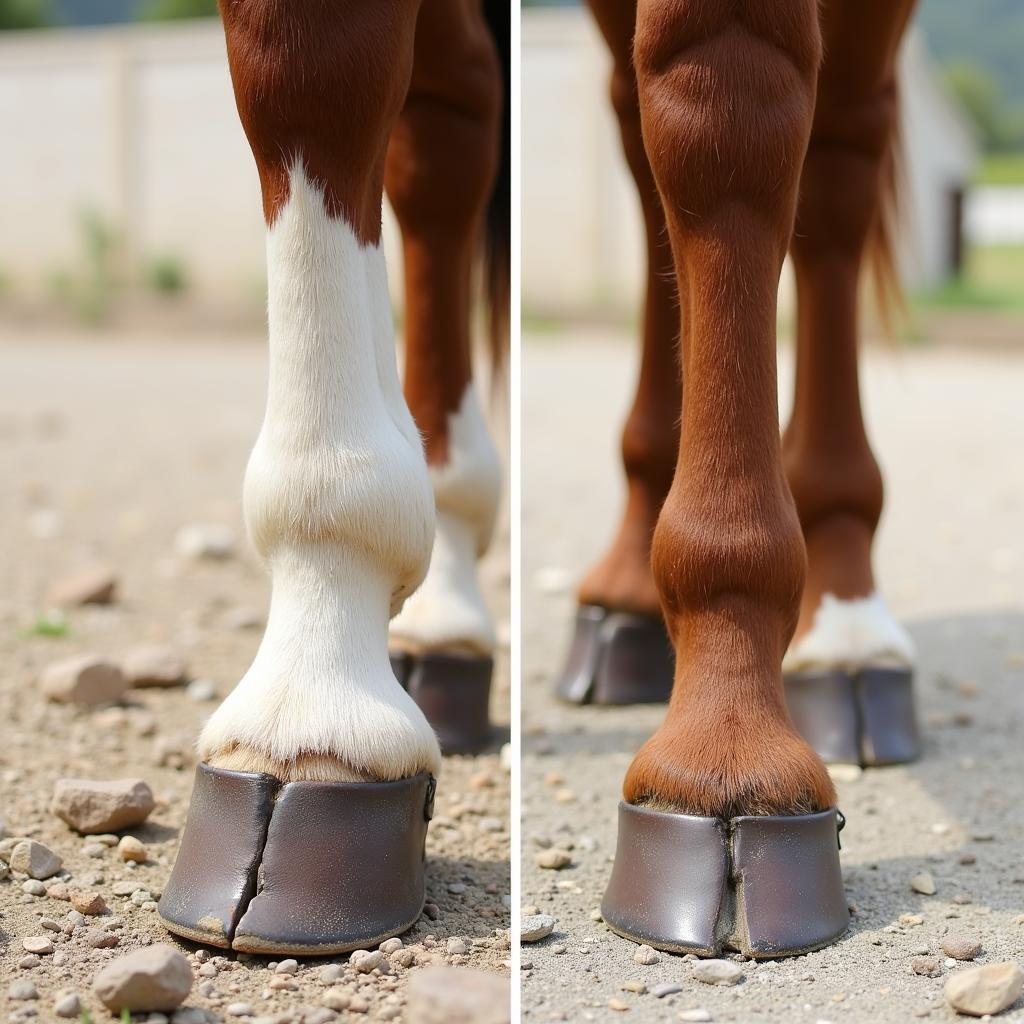Horse Hoof Shedding Sole is a natural process where the outer layer of the sole is exfoliated, revealing a new, healthier layer beneath. It’s essential for healthy hoof growth and function. Understanding this process can help horse owners maintain their horse’s hoof health and prevent potential problems. After this introduction, we’ll delve deeper into the intricacies of hoof shedding.
The Natural Cycle of Horse Hoof Shedding Sole
Just like our fingernails and hair, a horse’s hoof is constantly growing. The sole, the bottom part of the hoof, is made of keratinized tissue. This tissue hardens and grows outward, eventually wearing down and shedding off. The rate at which a horse sheds its sole can vary depending on factors like environment, diet, and activity level. A healthy horse will naturally shed its sole without any intervention.
Having the right grooming tools for horses is essential for maintaining healthy hooves. Regular cleaning and inspection can help you identify any potential issues early on.
Excessive dryness, cracks, or abnormal discoloration could indicate a problem and necessitate veterinary attention. Remember, proactive care is key to ensuring your horse’s well-being.
 Horse Hoof Shedding Sole Process
Horse Hoof Shedding Sole Process
Factors Affecting Horse Hoof Shedding Sole
Several factors influence the rate and process of hoof shedding. Environment plays a significant role, with dry conditions often leading to brittle hooves and faster shedding. Conversely, wet, muddy environments can soften the sole, potentially leading to slower shedding and an increased risk of thrush. Diet is another crucial factor, with a balanced diet rich in essential nutrients supporting healthy hoof growth and shedding. Finally, activity level impacts hoof wear and tear, affecting the shedding process.
Regular hoof care, including cleaning and trimming, is essential for supporting natural hoof shedding. A good horse brush set will make this process easier and more effective.
A farrier can help maintain the proper hoof shape and address any imbalances that may hinder natural shedding.
Recognizing Healthy vs. Unhealthy Hoof Shedding
Differentiating between normal horse hoof shedding sole and potential problems is vital for timely intervention. Healthy shedding usually involves thin layers peeling off, revealing a smooth, healthy sole underneath. However, thick, uneven shedding, accompanied by cracks, discoloration, or a foul odor, can indicate underlying issues like thrush, white line disease, or abscesses.
When to Consult a Vet About Horse Hoof Shedding Sole
While shedding is a natural process, some signs warrant professional attention. Consult your veterinarian if you notice any of the following:
- Thick, uneven sole shedding
- Cracks or fissures in the hoof
- Discoloration of the sole (e.g., black, yellow, or green)
- Foul odor emanating from the hoof
- Lameness or discomfort in the horse
“Regular hoof care is the cornerstone of preventing most hoof problems,” advises Dr. Emily Carter, an equine veterinarian with over 20 years of experience. “Early detection and treatment are crucial for minimizing long-term damage.”
 Healthy vs. Unhealthy Horse Hoof Shedding
Healthy vs. Unhealthy Horse Hoof Shedding
Conclusion
Understanding horse hoof shedding sole is fundamental for responsible horse ownership. By recognizing the natural shedding process and the factors influencing it, you can ensure your horse’s hooves remain healthy and functional. Regular hoof care, a balanced diet, and attentive observation are key to promoting healthy horse hoof shedding sole and preventing potential hoof problems.
FAQ
-
How often do horses shed their hooves? Horses shed their hooves continuously, although the rate varies depending on individual factors.
-
Is it normal for a horse’s hoof to peel? Yes, peeling is a normal part of the shedding process.
-
What can I do to promote healthy hoof shedding? Provide a balanced diet, maintain a clean environment, and schedule regular farrier visits.
-
When should I be concerned about hoof shedding? Consult your veterinarian if you observe thick, uneven shedding, cracks, discoloration, or a foul odor.
-
Can hoof shedding be painful for a horse? Healthy shedding is usually painless. However, underlying conditions associated with abnormal shedding can cause discomfort.
-
How does diet affect hoof shedding? A diet lacking essential nutrients can lead to weak, brittle hooves and abnormal shedding.
-
What role does a farrier play in hoof shedding? A farrier helps maintain proper hoof balance and addresses any issues that may impede healthy shedding.
For further support and guidance on horse hoof care, contact us at Phone Number: 0772127271, Email: [email protected], or visit our location at QGM2+WX2, Vị Trung, Vị Thuỷ, Hậu Giang, Việt Nam. Our customer service team is available 24/7. You can also find helpful articles like “grooming tools for horses” and “horse brush set” on our website.